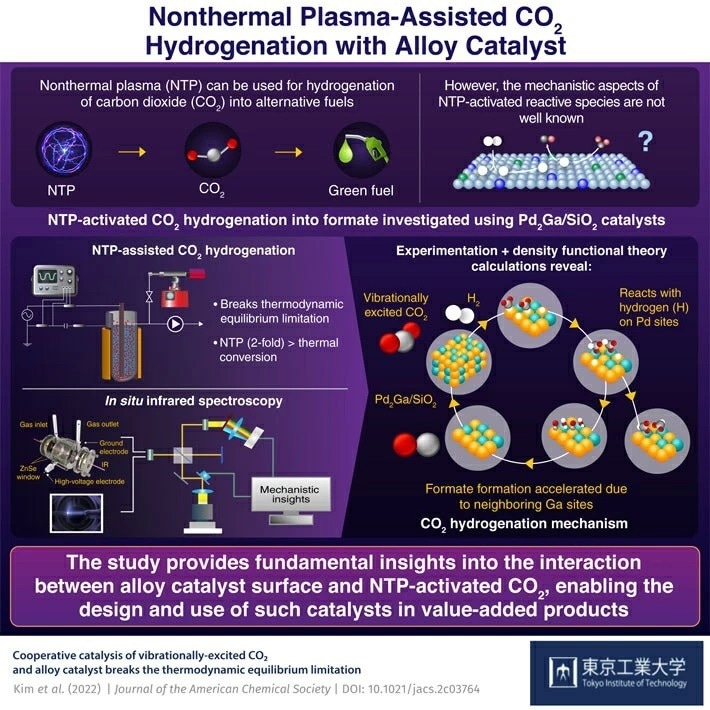To activate CO2 molecules for hydrogenation into alternative energy sources at low temperatures, nonthermal plasma (NTP) is utilized. This process also makes it possible to convert renewable power to chemical energy. To explore the hydrogenation route of NTP-promoted CO2 on the surface of Pd2Ga/SiO2 catalysts, researchers from Tokyo Tech utilized experimental and computational techniques.

Image Credit: Journal of the American Chemical Society.
The engineers can create new idea catalysts, thanks to the mechanistic insights from their work, which can increase the efficiency of CO2 hydrogenation catalysis.
Over the last several years, excessive CO2 emissions have raised serious concerns about climate change. Technologies that can not only cut and eliminate excess CO2 emissions but also convert them into compounds with additional value are being developed to address this issue. One such technique uses renewable hydrogen to hydrogenate CO2 and create alternative fuels.
Different methods have been developed throughout time to enhance CO2 hydrogenation in the presence of metallic catalysts. Nonthermal plasma stands out among them as the most promising (NTP).
Without deactivating metallic catalysts, which are susceptible to higher temperatures, it encourages hydrogenation of CO2 above the thermodynamic limit even at low temperatures. Despite this method’s growing use, little is known about how NTP-activated species interact with metallic catalysts.
Fortunately, a group of scientists from the Tokyo Institute of Technology (Tokyo Tech), Japan, under the direction of Prof. Tomohiro Nozaki, came up with a study to close this knowledge gap.
The researchers’ most recent discovery, which was reported in the Journal of the American Chemical Society, showed the kinetics of the reaction for NTP-aided CO2 hydrogenation on the surface of Pd2Ga/SiO2 alloy catalysts, which results in the synthesis of formate.
Reaction mechanisms like Eley-Rideal or E-R pathway have been proposed to explain efficient CO2 conversion at lower temperatures and the activation energy for this reaction decreases dramatically. Moreover, NTP produces a copious amount of vibrationally activated CO2 which is the key to enhancing CO2 conversion beyond the thermal equilibrium.
Tomohiro Nozaki, Professor, Department of Mechanical Engineering, Tokyo Institute of Technology
In a fluidized-bed dielectric barrier discharge reactor, the researchers looked at the reactions between NTP-activated CO2 and Pd2Ga/SiO2 alloy catalysts and contrasted them against traditional thermal catalysis.
The results showed that when NTP-assisted hydrogenation was used instead of thermal conversion, the amount of CO2 that was converted into formate increased by more than a factor of two. The researchers used density functional theory (DFT) simulations and in situ spectroscopic investigation to better understand the mechanics of the conversion in question.
The results showed that NTP activation produced vibrationally excited CO2 molecules, which then immediately reacted through the E-R route with hydrogen atoms adsorbed by the Pd sites on the catalyst. Monodentate-formate, also known as m-HCOO, was created when one of the O atoms from the reacting species was adsorbed at the nearby Ga site. For the identical m-HCOO species, the DFT simulations also revealed a breakdown route.
This theoretical and practical investigation has shown that NTP may increase CO2 hydrogenation to levels that conventional thermal approaches can scarcely achieve. Additionally, it offered mechanistic insights into the relationship between NTP-activated CO2 and catalysts, which may be used to create better catalysts and enhance the hydrogenation process.
With our research, we wanted to accelerate the waste to wealth initiative. Capturing CO2 and using it as feedstock for synthesis of fuels and valuable chemicals will not only help us deal with climate problem but also slow down fossil fuel depletion to some extent.
Tomohiro Nozaki, Professor, Department of Mechanical Engineering, Tokyo Institute of Technology
CO2 recycling, innovative plasma-catalysis concept:Side view, DBD generated in fluidized bed reactor
Side view, DBD generated in fluidized bed reactor. Video Credit: Tokyo Institute of Technology.
Journal Reference:
Kim, D.-Y., et al. (2022) Cooperative Catalysis of Vibrationally Excited CO2 and Alloy Catalyst Breaks the Thermodynamic Equilibrium Limitation. Journal of the American Chemical Society. doi.org/10.1021/jacs.2c03764.